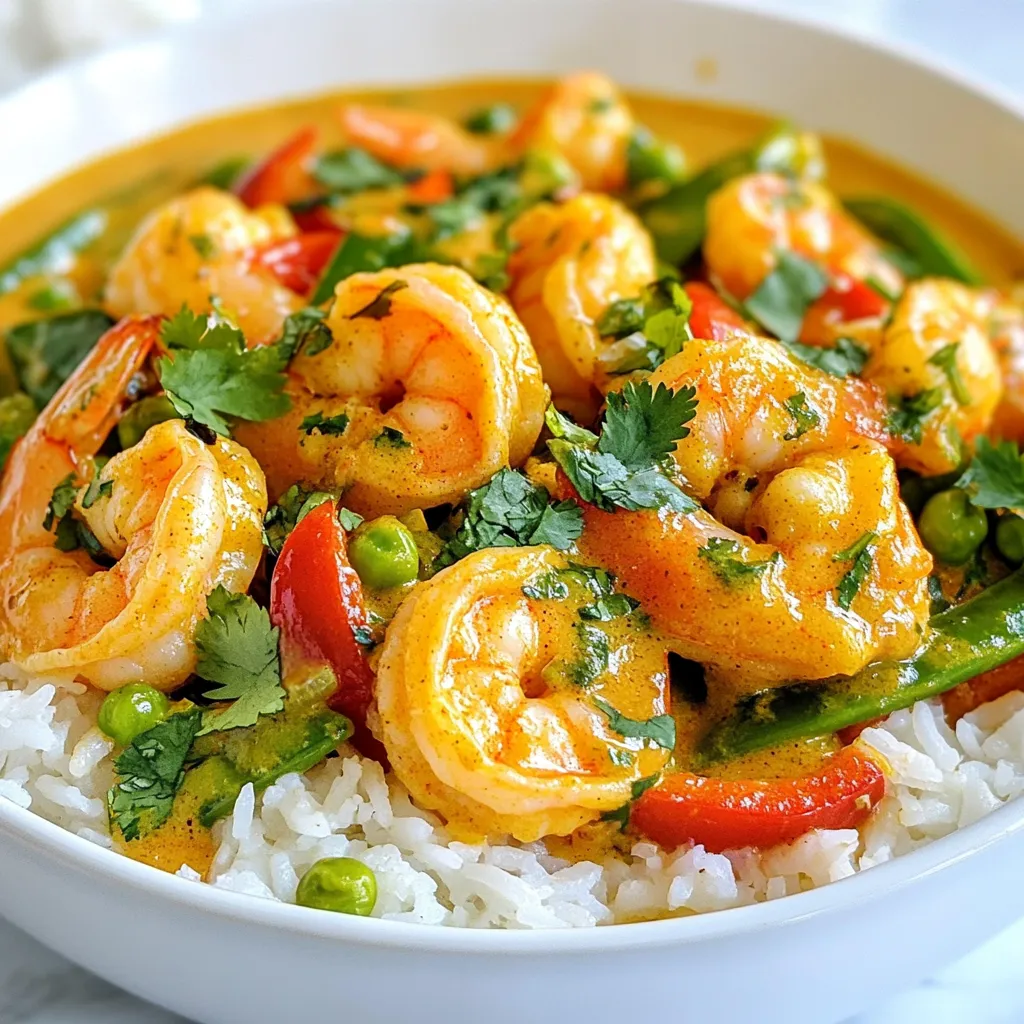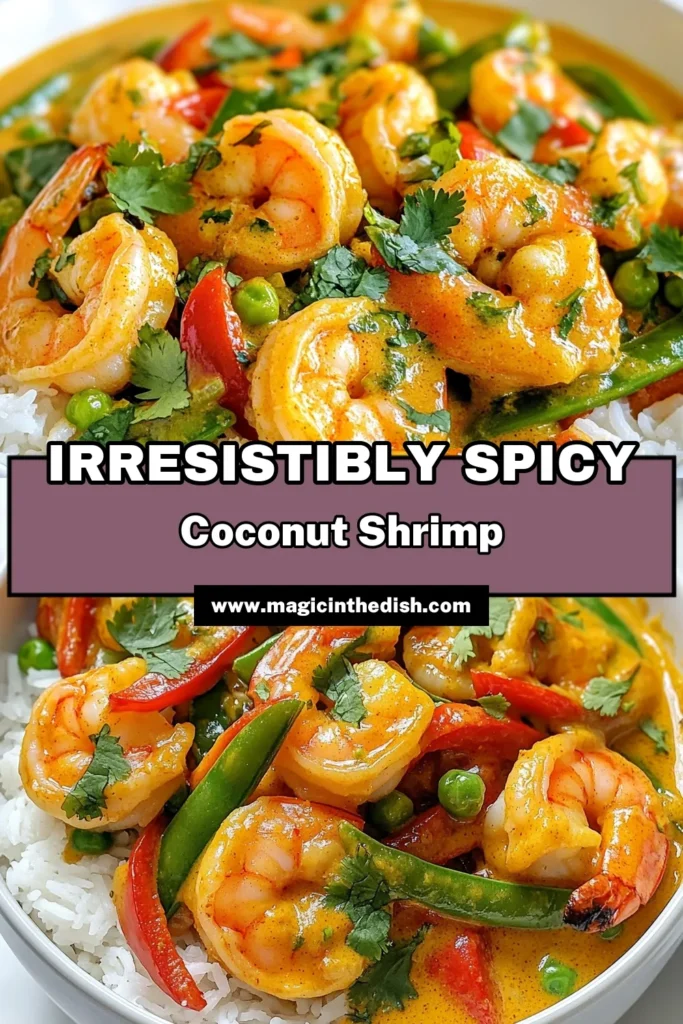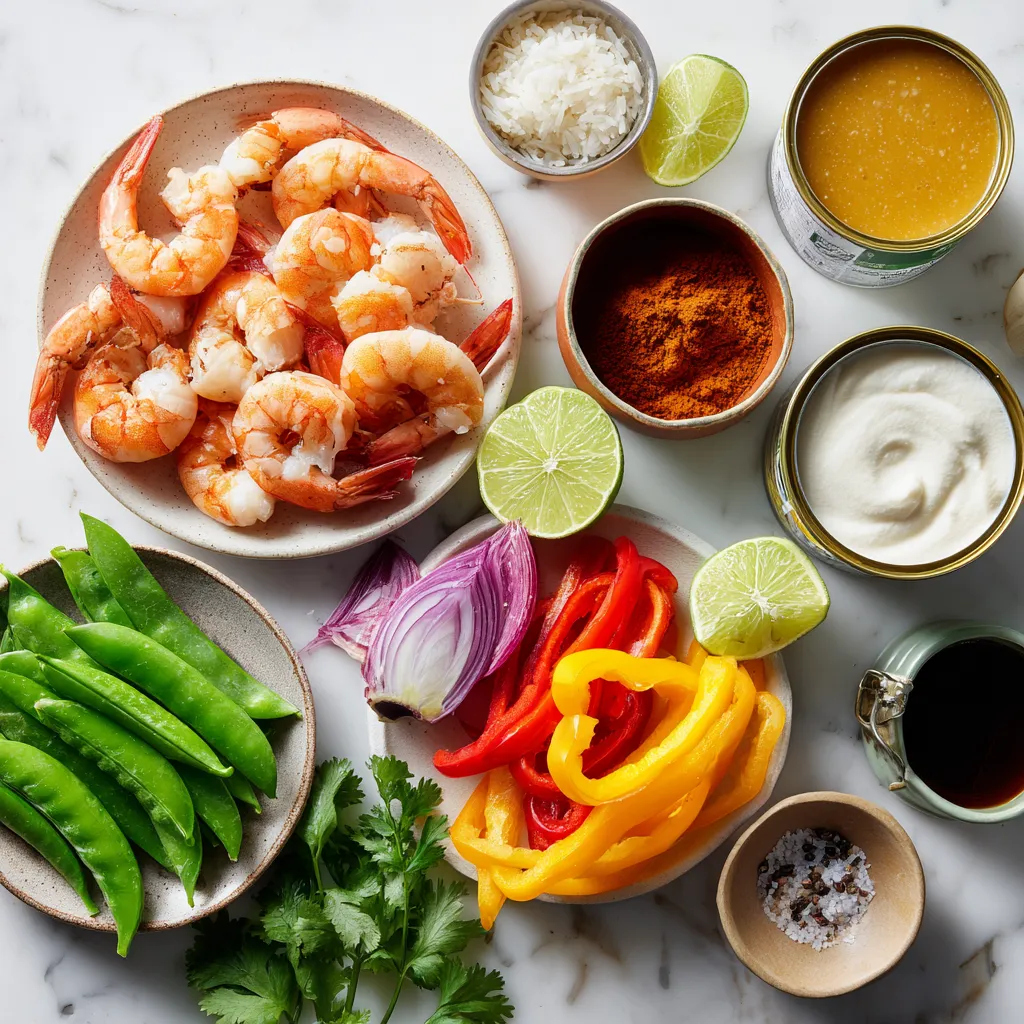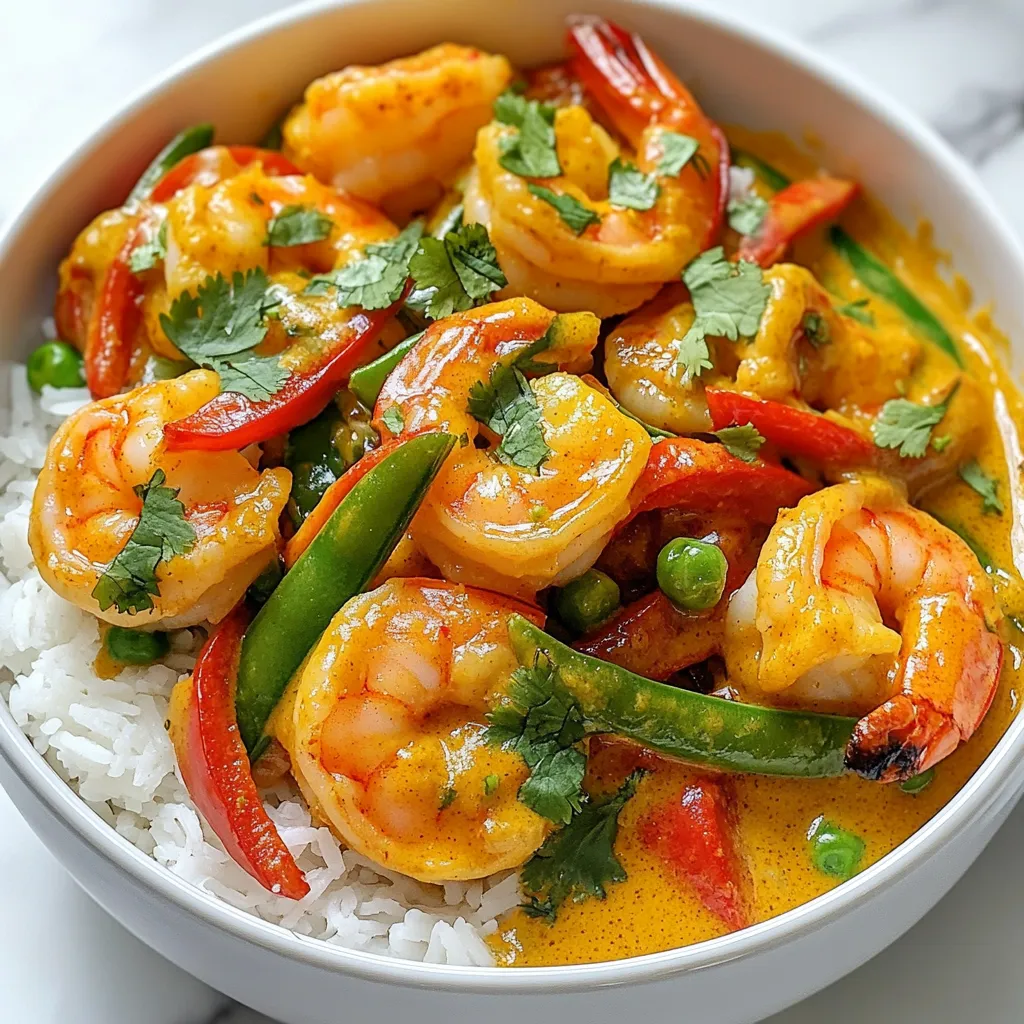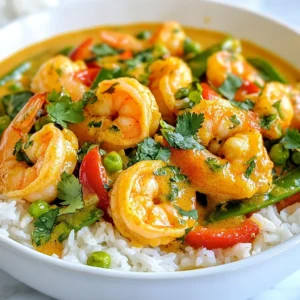WANT TO SAVE THIS RECIPE?
Are you ready to spice up your dinner table? This Spicy Coconut Curry Shrimp recipe is simple, delicious, and packed with flavor. With just a few ingredients, you can create a vibrant meal that will impress your family and friends. I’ll guide you through each step, from the rich flavors to helpful tips. Let’s dive in and transform shrimp into a tropical delight you can’t resist!

Why I Love This Recipe
- Bold Flavors: This dish combines the rich creaminess of coconut milk with the heat from red curry paste, creating a delightful explosion of flavors in every bite.
- Quick and Easy: With a total prep and cook time of only 30 minutes, this recipe is perfect for busy weeknights when you want a delicious meal without spending hours in the kitchen.
- Versatile Ingredients: The recipe allows for substitutions and additions, making it easy to customize based on what you have in your pantry or to cater to dietary preferences.
- Colorful Presentation: The vibrant colors of the shrimp, bell peppers, and snap peas make this dish visually appealing, making it a feast for the eyes as well as the palate.
Ingredients
Full List of Ingredients
– 1 pound large shrimp, peeled and deveined
– 1 can (14 oz) coconut milk
– 2 tablespoons red curry paste
– 1 tablespoon ginger, freshly grated
– 2 garlic cloves, minced
– 1 medium onion, finely chopped
– 1 bell pepper (red or yellow), sliced into thin strips
– 1 cup snap peas, trimmed and cleaned
– 1 tablespoon freshly squeezed lime juice
– 1 tablespoon fish sauce (substitute with soy sauce for vegetarian option)
– 2 tablespoons vegetable oil (such as canola or sunflower)
– Fresh cilantro, for garnish
– Salt and pepper to taste
Ingredient Substitutions
You can switch ingredients based on your taste. For a vegetarian dish, use tofu or chickpeas instead of shrimp. You can also swap fish sauce with soy sauce for a vegan option. If you don’t have red curry paste, use green curry paste. Coconut milk can be replaced with almond milk, but the flavor will change. For a spicier dish, add more curry paste or some chili flakes.
Nutritional Information
This recipe serves four people. Each serving has around:
– Calories: 350
– Protein: 24g
– Carbohydrates: 15g
– Fat: 22g
– Fiber: 3g
– Sugar: 4g
This dish is rich in protein from the shrimp. It also has healthy fats from the coconut milk and offers vitamins from the veggies. Enjoy this meal as part of a balanced diet!

Step-by-Step Instructions
Preparation Steps Overview
Before you start cooking, gather all your ingredients. This will make the process smooth and easy. You need:
– 1 pound large shrimp, peeled and deveined
– 1 can (14 oz) coconut milk
– 2 tablespoons red curry paste
– 1 tablespoon ginger, freshly grated
– 2 garlic cloves, minced
– 1 medium onion, finely chopped
– 1 bell pepper (red or yellow), sliced into thin strips
– 1 cup snap peas, trimmed and cleaned
– 1 tablespoon freshly squeezed lime juice
– 1 tablespoon fish sauce (or soy sauce)
– 2 tablespoons vegetable oil
– Fresh cilantro for garnish
– Salt and pepper to taste
Detailed Cooking Process
1. Heat the vegetable oil in a large skillet over medium heat. Wait until it shimmers.
2. Add the chopped onion and sliced bell pepper. Cook for 4-5 minutes until soft and the onion is clear.
3. Stir in the minced garlic and grated ginger. Cook for one more minute until fragrant.
4. Mix in the red curry paste. Let it cook for 2 minutes to deepen the flavor.
5. Pour in the coconut milk slowly. Stir well to mix in the curry paste. Bring to a gentle simmer.
6. Add the shrimp to the skillet. Cook for 3-4 minutes until the shrimp turns pink and opaque.
7. Toss in the snap peas, lime juice, and fish sauce or soy sauce. Cook for 2-3 minutes until the peas are tender yet bright.
8. Season with salt and pepper to taste. Adjust as needed. Remove from heat.
9. Serve over rice or noodles. Garnish with fresh cilantro for added flavor and color.
Tips for Perfect Cooking
– Use fresh shrimp for the best taste. Frozen shrimp works too; just thaw it first.
– Adjust the curry paste amount for your spice preference. Add more for extra heat!
– Serve hot for the best flavor. It tastes great with lime wedges on the side.
– For a fun twist, add vegetables like broccoli or carrots. They add crunch and color.
Tips & Tricks
Balancing Flavors in Your Curry
To make your curry shine, balance is key. Use the right amount of salt to enhance flavors. A splash of lime juice adds brightness. If it tastes too spicy, add more coconut milk to cool it down. Taste as you go. Adjust to your liking.
Enhancing the Dish with Garnishes
Garnishes make your dish more appealing. Fresh cilantro adds color and freshness. Lime wedges offer an extra tang. You can also add sliced red chili for a pop of color. Serve in a deep bowl for a stunning look.
Storing Leftovers and Reheating
Store leftovers in an airtight container. Keep in the fridge for up to three days. To reheat, use a skillet over low heat. Stir gently until warm. Avoid microwaving, as it can overcook the shrimp. Enjoy your delicious curry again!
Pro Tips
- Use Fresh Ingredients: Fresh shrimp, ginger, and vegetables will elevate the flavor of your curry and enhance the overall dish.
- Adjust Spice Levels: If you prefer a milder curry, reduce the amount of red curry paste or add more coconut milk to tone down the heat.
- Perfectly Cook Shrimp: Cook the shrimp just until they turn pink and opaque; overcooking can make them tough and rubbery.
- Garnish with Purpose: Fresh cilantro not only adds color but also a burst of flavor; consider adding lime wedges for an extra zesty finish.

Variations
Vegetarian and Vegan Adaptations
You can easily make this dish vegetarian or vegan. Simply swap the shrimp for firm tofu or chickpeas. Use soy sauce instead of fish sauce for a plant-based option. The coconut milk and red curry paste still give great flavor. You can add more vegetables like mushrooms, zucchini, or spinach. These will add texture and taste without losing the essence of the curry.
Spice Level Adjustments
If you like heat, add more red curry paste. A pinch of red pepper flakes can also spice things up. For a milder dish, use less curry paste and some coconut cream. You can also add a bit of sugar to balance the heat. Taste as you go to find the perfect level for you.
Serving Suggestions
Serve your spicy coconut curry shrimp over warm rice or noodles. Jasmine rice or rice noodles work well. You can add fresh cilantro on top for a burst of flavor. Lime wedges on the side add a zesty touch. Consider pairing it with a simple salad or some steamed veggies for a complete meal. Enjoy experimenting with these variations!
Storage Info
How to Store Leftovers
To store leftovers, let the curry cool down first. Then, place it in an airtight container. You can keep it in the fridge for up to three days. Make sure to seal it well to prevent any strong smells in your fridge.
Freezing Instructions
If you want to freeze your spicy coconut curry shrimp, use a freezer-safe container. Divide the curry into portions for easy use later. It can last in the freezer for up to two months. When you’re ready to eat, thaw it overnight in the fridge before reheating.
Reheating Techniques
To reheat the curry, place it in a skillet over low heat. Stir it often to warm it evenly. You can add a splash of coconut milk if it seems too thick. Another option is to microwave it in a bowl. Cover the bowl loosely and heat for one to two minutes. Stir halfway to ensure it heats through. Always check the temperature before serving to make sure it’s hot.
FAQs
What is red curry paste and how to use it?
Red curry paste is a mix of spices and herbs. It usually has chili, garlic, lemongrass, and ginger. This paste gives your dish a rich, spicy flavor. To use it, simply stir it into your sautéed veggies. Let it cook for a few minutes to release its aroma. Then, add coconut milk for a creamy sauce.
Can I use frozen shrimp for this recipe?
Yes, you can use frozen shrimp. Just make sure to thaw it first. You can thaw shrimp by placing it in cold water for about 15 minutes. After thawing, peel and devein if needed. Then, you can follow the recipe as usual.
What to serve with Spicy Coconut Curry Shrimp?
This dish pairs well with rice or noodles. Fluffy jasmine rice is a great choice. You can also serve it with crusty bread to soak up the sauce. For a fresh touch, add a side salad or steamed veggies.
How can I make this dish less spicy?
To reduce the spice, use less red curry paste. Start with one tablespoon instead of two. You can also add more coconut milk to balance the heat. Adding sugar or honey can help, too. These adjustments will make the dish milder while keeping it tasty.
In this blog post, I covered the key ingredients for Spicy Coconut Curry Shrimp, including substitutions and nutritional info. I shared a step-by-step guide for cooking and tips to balance flavors. We also explored vegetarian options, spice adjustments, and serving ideas.
Remember, storing and reheating properly can keep this dish tasty. Enjoy experimenting with the recipe and making it your own. Happy cookin
Spicy Coconut Curry Shrimp
A flavorful and spicy shrimp dish cooked in creamy coconut milk with aromatic spices and fresh vegetables.
Prep Time 10 minutes mins
Cook Time 10 minutes mins
Total Time 20 minutes mins
Course Main Course
Cuisine Thai
Servings 4
Calories 350 kcal
- 1 pound large shrimp, peeled and deveined
- 1 can coconut milk (14 oz)
- 2 tablespoons red curry paste
- 1 tablespoon ginger, freshly grated
- 2 cloves garlic, minced
- 1 medium onion, finely chopped
- 1 bell pepper red or yellow, sliced into thin strips
- 1 cup snap peas, trimmed and cleaned
- 1 tablespoon freshly squeezed lime juice
- 1 tablespoon fish sauce (or soy sauce for vegetarian option)
- 2 tablespoons vegetable oil (such as canola or sunflower)
- to taste salt and pepper
- to garnish fresh cilantro
In a large skillet or wok, heat the vegetable oil over medium heat until shimmering.
Add the finely chopped onion and sliced bell pepper to the skillet. Sauté for about 4-5 minutes, or until the vegetables have softened and the onion is translucent.
Incorporate the minced garlic and grated ginger into the mixture, cooking for an additional minute until both are aromatic.
Stir in the red curry paste, ensuring it combines thoroughly with the sautéed vegetables. Let it cook for about 2 minutes to enhance the flavors.
Gradually pour in the coconut milk, stirring gently to incorporate the curry paste completely. Bring the mixture to a gentle simmer.
Add the shrimp to the skillet, cooking for 3-4 minutes. The shrimp should turn pink and opaque, indicating they're cooked through.
Introduce the snap peas, lime juice, and fish sauce or soy sauce into the skillet. Cook for another 2-3 minutes until the snap peas are tender-crisp, maintaining their vibrant color.
Season the curry with salt and pepper to taste. Once the flavors are balanced, remove the skillet from heat.
Serve the spicy coconut curry shrimp over a bed of fluffy rice or noodles, and garnish with freshly chopped cilantro for a pop of color and flavor.
For an elegant touch, use a deep bowl and arrange the shrimp artistically on top of the rice or noodles. Drizzle a bit of the curry sauce over the top and sprinkle extra cilantro for garnish. Enjoy your meal with lime wedges on the side for an extra zesty kick!
Keyword coconut, curry, quick meal, shrimp, spicy
WANT TO SAVE THIS RECIPE?
